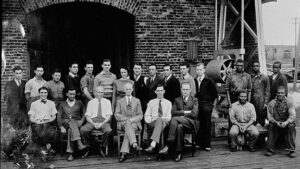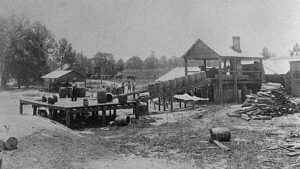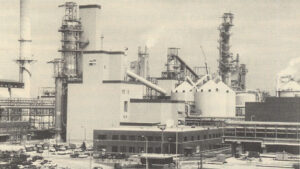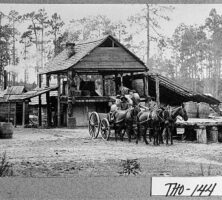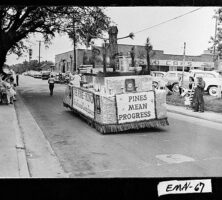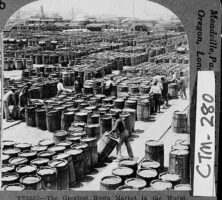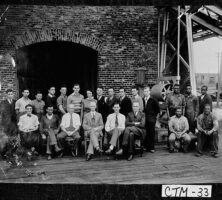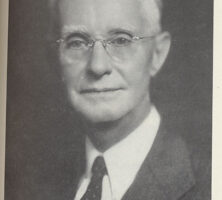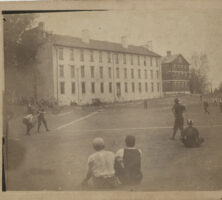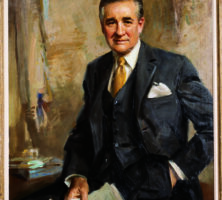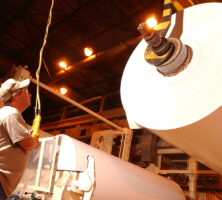The New Georgia Encyclopedia is supported by funding from A More Perfect Union, a special initiative of the National Endowment for the Humanities.
In 1935 Union Bag and Paper, a New Jersey-based paper and packaging manufacturer, built a mill in Savannah, which became the company's largest facility in the Southeast. In 1956 Union Bag merged with Camp Manufacturing to form Union Camp, which was acquired by International Paper in 1999.
From Union Camp Corporation: A Legacy of Leadership, by W. Craig McClelland
The New Georgia Encyclopedia does not hold the copyright for this media resource and can neither grant nor deny permission to republish or reproduce the image online or in print. All requests for permission to publish or reproduce the resource must be submitted to the rights holder.
An employee works with rosin at the Union Bag and Paper Company, later Union Camp. Rosin, a distillation of turpentine, is used in the manufacture of paper. A by-product of timbering and naval stores production, the southeast's supply of rosin is drawn largely from loblolly and swamp pines.
Courtesy of Georgia Historical Society, Foltz Photography Studio (Savannah, Ga.), photographs, 1899-1960, #1360-21-03-13.
The New Georgia Encyclopedia does not hold the copyright for this media resource and can neither grant nor deny permission to republish or reproduce the image online or in print. All requests for permission to publish or reproduce the resource must be submitted to Georgia Historical Society.
A Thomas County turpentine still produces rosin and turpentine in the early 1900s. Along with other naval stores products, rosin and turpentine were used in the construction and repair of sea vessels.
Courtesy of Georgia Archives, Vanishing Georgia, #
tho323.
The New Georgia Encyclopedia does not hold the copyright for this media resource and can neither grant nor deny permission to republish or reproduce the image online or in print. Requests for permission to publish or reproduce the resource should be submitted to the Georgia Archives.
A turpentine still in Thomas County, pictured circa 1895, distills turpentine and rosin from the crude gum harvested from pine trees. The highest grade of turpentine was distilled from longleaf yellow and slash pine varieties.
Courtesy of Georgia Archives, Vanishing Georgia, #
tho144a.
The New Georgia Encyclopedia does not hold the copyright for this media resource and can neither grant nor deny permission to republish or reproduce the image online or in print. Requests for permission to publish or reproduce the resource should be submitted to the Georgia Archives.
A parade float, pictured in the late 1950s, progresses through Swainsboro, the seat of Emanuel County, during the Pine Tree Festival. Forest-related industry was an economic mainstay for the county from the 1870s through the 1960s.
Courtesy of Georgia Archives, Vanishing Georgia, #
emn067.
The New Georgia Encyclopedia does not hold the copyright for this media resource and can neither grant nor deny permission to republish or reproduce the image online or in print. Requests for permission to publish or reproduce the resource should be submitted to the Georgia Archives.
Laborers on a Savannah dock prepare barrels of rosin for shipment, circa 1895. From the 1890s until 1945, the ports at Savannah and Brunswick shipped out most of the world's supply of naval stores.
Courtesy of Georgia Archives, Vanishing Georgia, #
ctm280.
The New Georgia Encyclopedia does not hold the copyright for this media resource and can neither grant nor deny permission to republish or reproduce the image online or in print. Requests for permission to publish or reproduce the resource should be submitted to the Georgia Archives.
Charles Herty (seated, fourth from left) is pictured with staff members at his Savannah Pulp and Paper Laboratory, circa 1933. Herty founded the lab in 1931 to develop techniques for producing newsprint from southern pine trees.
Courtesy of Georgia Archives, Vanishing Georgia, #
ctm033.
The New Georgia Encyclopedia does not hold the copyright for this media resource and can neither grant nor deny permission to republish or reproduce the image online or in print. Requests for permission to publish or reproduce the resource should be submitted to the Georgia Archives.
Charles Herty, a native of Milledgeville, was a renowned chemist known for his contributions to both the forestry and paper industries during his career. While a professor at the University of Georgia in the 1890s, Herty also established the university's athletic program.
Courtesy of Georgia Historical Society, Foltz Photography Studio (Savannah, Ga.), photographs, 1899-1960, #1360-25-10-14.
The New Georgia Encyclopedia does not hold the copyright for this media resource and can neither grant nor deny permission to republish or reproduce the image online or in print. All requests for permission to publish or reproduce the resource must be submitted to Georgia Historical Society.
University of Georgia students play baseball in 1893 at a field located on the northwest corner of campus. Charles Herty, a chemistry professor who was named director of the Department of Physical Culture at UGA in 1894, enlarged the field and built a grandstand in 1896. The site was later named Herty Field in his honor.
The New Georgia Encyclopedia does not hold the copyright for this media resource and can neither grant nor deny permission to republish or reproduce the image online or in print. Requests for permission to publish or reproduce the resource should be submitted to the Hargrett Manuscript and Rare Book Library at the University of Georgia.
The New Georgia Encyclopedia does not hold the copyright for this media resource and can neither grant nor deny permission to republish or reproduce the image online or in print. All requests for permission to publish or reproduce the resource must be submitted to the rights holder.
Charles Herty, an internationally recognized chemist from Georgia, meets in Savannah with leaders of the forestry and paper industries in the 1930s. Herty stands fourth from the left, and the philanthropist George Foster Peabody sits in the center.
Courtesy of Georgia Archives, Vanishing Georgia, #
ctm236.
The New Georgia Encyclopedia does not hold the copyright for this media resource and can neither grant nor deny permission to republish or reproduce the image online or in print. Requests for permission to publish or reproduce the resource should be submitted to the Georgia Archives.
Georgia-Pacific's corporate headquarters moved to Atlanta in 1982 after being based on the West Coast for nearly thirty years. In 2005 the company was acquired by Koch Industries and became a privately held, wholly owned subsidiary. Georgia-Pacific continues to operate from its Atlanta headquarters.
Courtesy of Georgia-Pacific
The New Georgia Encyclopedia does not hold the copyright for this media resource and can neither grant nor deny permission to republish or reproduce the image online or in print. All requests for permission to publish or reproduce the resource must be submitted to the rights holder.
Upon founding the Georgia Hardwood Lumber Company (later Georgia-Pacific) in 1927, Owen R. Cheatham became an early pioneer in the southern timber industry. Under his command, Georgia-Pacific was one of the nation's fastest-growing businesses in the 1950s.
Courtesy of Georgia-Pacific
The New Georgia Encyclopedia does not hold the copyright for this media resource and can neither grant nor deny permission to republish or reproduce the image online or in print. All requests for permission to publish or reproduce the resource must be submitted to the rights holder.
Pictured here in 2003, native Georgian A. D. "Pete" Correll joined Georgia-Pacific in 1988 as a senior vice president. He also served as an executive vice president and chief operating officer before becoming chairman and chief executive officer in 1993.
Courtesy of Georgia-Pacific
The New Georgia Encyclopedia does not hold the copyright for this media resource and can neither grant nor deny permission to republish or reproduce the image online or in print. All requests for permission to publish or reproduce the resource must be submitted to the rights holder.
A Georgia-Pacific employee rewinds printing paper in 2004. The machine on the left is the rewinder.
Courtesy of Georgia-Pacific
The New Georgia Encyclopedia does not hold the copyright for this media resource and can neither grant nor deny permission to republish or reproduce the image online or in print. All requests for permission to publish or reproduce the resource must be submitted to the rights holder.

